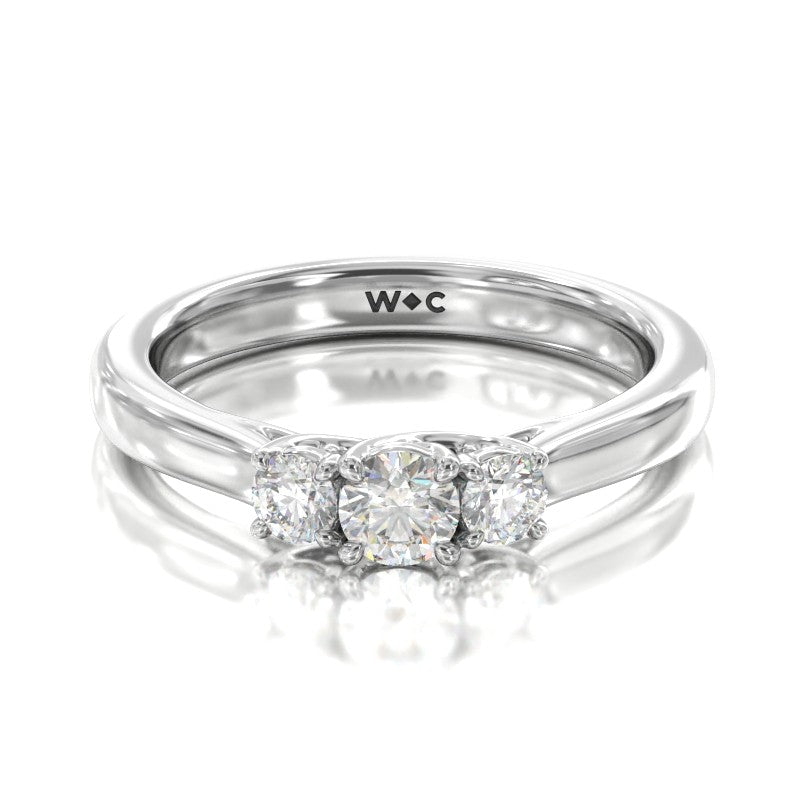Your Bag
Your cart is currently empty
Free Shipping
Buy Now Pay Later
100% Secure Checkout
Use code FIRST10 for 10% OFF on first order *on regular priced items.
Your cart is currently empty
Free Shipping
Buy Now Pay Later
100% Secure Checkout
Use code FIRST10 for 10% OFF on first order *on regular priced items.


Natural diamonds are rare and require a lot of heavy mining, which inspired scientists in 1954 to perfect methods for creating lab-created diamonds. The only difference between lab-created diamonds and natural diamonds is that one is created in a lab and the other in the earth. Lab grown diamonds feature the same chemical composition, optical properties and physical features as natural diamonds.
The process to create a lab grown diamond is similar to the process to create natural diamonds–the only difference is one occurs within the earth’s crust and the other occurs in a laboratory. To create a lab grown diamond, the manufacturing process replicates conditions that create a natural diamond–extreme temperatures and pressures that turn carbon into a diamond.
Manufacturers have two ways to create lab diamonds–High Pressure High Temperature (HPHT) and Chemical Deposition (CVD):
Symptoms of an infected ear piercing include:
There are plenty of lab diamond myths floating around, so let’s sort these out.
Myth 1: Lab diamonds are not real, they are fake
Truth: Lab diamonds are optically, chemically and physically the same as earth-mined diamonds. One is created in a lab and the other in the earth. To create a lab grown diamond, the manufacturing process replicates conditions that create a natural diamond–extreme temperatures and pressures that turn carbon into a diamond.
Myth 2: Lab diamonds are of inferior quality
Truth: Lab grown diamonds are of the same quality, if not better than mined diamonds. The diamond seed used to create lab-grown diamonds is often a high-quality diamond bit. Large, high-quality natural diamonds are rare and more costly. You’ll be able to get a larger, higher-quality lab-grown diamond and make the most of your budget.
Myth 3: The color of lab diamonds changes with time
Truth: No, a lab-grown diamond’s color remains the same over time. Natural diamonds do not yellow with age, and lab-grown diamonds won’t either because they have the same chemical makeup.
Myth 4: Lab diamonds cost less because of their poor quality
Truth: Lab diamonds cost less because they are created in sophisticated labs, which means they have a faster turnaround time, less impact on the earth, use less labor and are easier to track the supply chain. All of these factors add up so you’ll pay less for a high-quality lab diamond.
Myth 5: Lab diamonds look different from earth-mined diamonds
Truth: Even a trained gemologist will find it difficult to differentiate between the two. The differences between natural diamonds and lab grown diamonds cannot be seen with the naked eye. Natural diamonds have tiny amounts of nitrogen but lab diamonds do not. This is one way gemologists differentiate between lab grown or natural.
Myth 6: Lab diamond and Cubic Zirconia are the same
Truth: Lab diamonds are made of carbon–it is 100% real, while Cubic Zirconia is a diamond simulant. Cubic zirconia is also a lab-created stone, but its crystal structure and chemical composition is completely different from a lab diamond. While lab-grown diamonds are made of carbon, cubic zirconia is the cubic crystalline form of zirconium dioxide.
Myth 7: Lab diamonds are not certified
Truth: World-renowned organizations, such as GIA and IGI grade and certify lab diamonds. The International Gemological Institute (IGI) was established back in 1975, and now has headquarters all over the globe. The independent laboratory studies colored stones along with lab grown diamonds to determine authenticity. Following an assessment, the experts compile an IGI lab grown diamond report to outline the results. Vendors can display the IGI certificate along with the IGI diamond, allowing potential buyers to verify the diamond is authentic.
You’ll find lab diamonds in all types of jewelry–from a simple solitaire necklace to sparkling stud earrings to extravagant engagement rings. Their popularity continues to increase because of the long list of benefits:
Are lab diamonds really ethical?
Lab diamonds are ethically sourced and considered “conflict-free.” You can pinpoint the origin of lab grown diamonds.
Do lab diamonds sparkle?
Lab grown diamonds are the same chemical composition, optical properties and physical features as natural diamonds, so they sparkle the same way as well!
Are lab diamonds and cubic zirconia the same?
Cubic zirconia and lab diamonds are not the same. Cubic zirconia is also a lab-created stone, but its crystal structure and chemical composition is completely different. While lab-grown diamonds are made of carbon, cubic zirconia is the cubic crystalline form of zirconium dioxide.
Is a lab grown diamond the same as moissanite?
No, these are two different stones. Lab-grown diamonds are made of carbon while moissanite is made of silicon carbide
Are lab grown diamonds durable?
Lab diamonds have the same hardness (10 on the hardness scale) as natural diamonds, so they’re durable.

starting at:$1,230

starting at:$330

Inside Out Lab Diamond Oval Hoops
starting at:$500

Oval Lab Diamond Halo Earrings
starting at:$600

Lab Diamond Three Stone Cluster Pendant
starting at:$540

Lab Double Bail Round Diamond Pendant
starting at:$1,160

Three Stone Round Brilliant Cut 0.50ct Lab Diamond Ring
starting at:$670

Lab Double Bail Round Diamond Pendant
starting at:$690